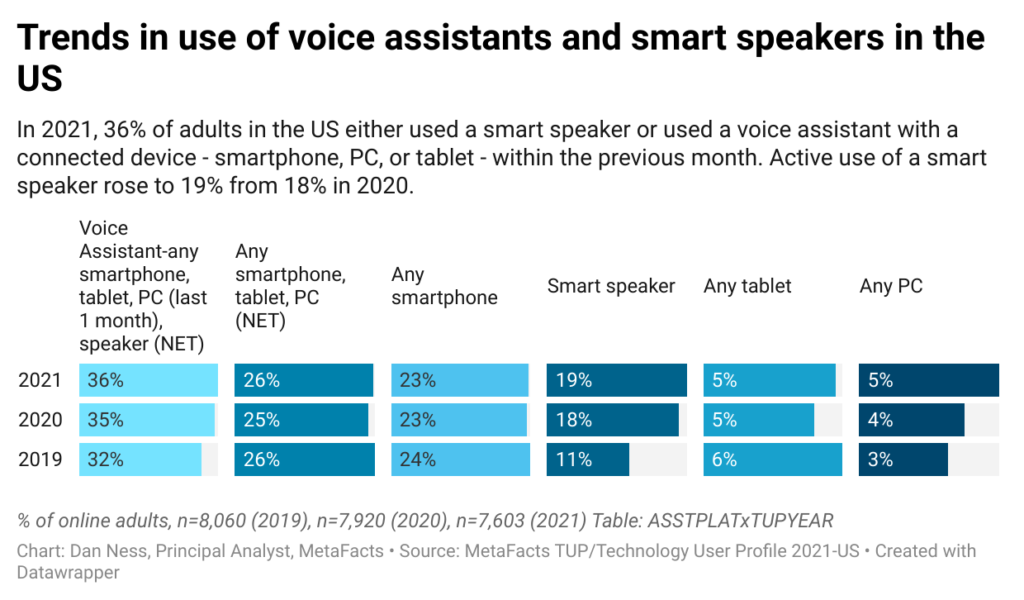Google aims to be ubiquitous and have competitive offerings to Apple, Amazon, and others. As a class, voice assistants and speakers have expanded in use by fits and starts. Only one in four Americans use a Google voice assistant or Google-brand speaker. This MetaFAQs profiles these active voice users by their age, age within gender, employment status, presence of children, life stage, number of computers used, and mix of technology ecosystems.
Profile of Americans actively using Amazon Alexa or Echo speakers
Making it easy to buy products goes well beyond Amazon’s 1-click online screens – with Amazon’s Alexa voice assistant. Amazon offers its voice assistant and smart speaker competitors to Apple, Google, and others. Only one in five American adults regularly use Amazon Alexa or an Amazon-branded smart speaker. This MetaFAQs profiles American active Amazon Alexa & Echo smart speaker users by several critical demographic and behavioral factors distinctive from the average American online adult: age group and age within gender, employment status, presence of children, life stage, number of PCs used, and mix of technology ecosystems.
Trends in voice assistant usage
Voices have the promise to enable a keyboard-free digital experience, and yet regular usage has not reached even half of the population. This MetaFAQs reports on the percentage of online adults in the US, Germany, UK, and Japan that regularly use a voice assistant or smart speaker.
Which hearables products are in active use?
More and more people are listening—to their devices, that is. Over half of online adults in most countries surveyed actively use hearables products—those technology products focused on listening activities—with Japan close behind at 45% of tech users. American online adults have the highest rates of using hearables products of all countries surveyed.
This MetaFAQs reports on hearables product use by country and age group in the US, UK, Germany, and Japan in 2021. Hearables products identified included: webcams, wireless Bluetooth headsets or headphones, voice assistants, voice-enabled speakers, VR headsets, and smart displays.
How often are voice assistants being used?
Are voice assistants such as Apple Siri or Amazon Alexa in as widespread usage as imagined? How recently have online adults in the US, UK, Germany, and Japan used a voice assistant? How does voice assistant use compare when using a smartphone versus a computer? Between 26% and 38% of online adults in these countries have used a voice assistant with a smartphone, and between 10% and 13% used a computer. This MetaFAQs reports on the recency of voice assistant usage among online adults in the US, the UK, Germany, and Japan. It further splits smartphone and computer usage by the age group of Americans.
Smart speaker penetration
Smart speakers are making themselves heard, although at a relatively low volume. Between 9% and 19% of online adults across the US, UK, Germany, and Japan regularly use at least one smart speaker – a wireless speaker that can be used with a voice assistant. They skew somewhat younger than the average online adult. This MetaFAQs reports on the percentage of online adults in the US, Germany, the UK, and Japan who regularly use a smart speaker by age group.
Which hearables products are in active use by Americans?
Listening and hearing activities with connected devices are widely practiced. To help, online Americans use many hearables devices: webcams, voice assistants, wireless Bluetooth headsets, smart speakers, VR headsets, or smart displays. This includes 143.9 million online American adults, or two in three (66%). This MetaFAQs reports on the active penetration rates of these audio-oriented devices split by age group and details the rapidly-changing adoption rates by life stage.
Profile of voice assistant users
Using our voice offers the chance to get things done without typing when using a smart speaker or another connected device – smartphone, PC, or tablet. However, current usage has not reached even half of the population. This MetaFAQs reports on the percentage of online adults in the US, Germany, UK, and Japan that regularly use a voice assistant or smart speaker, detailed by age group.
Smart speakers among young and old
How deeply have smart speakers penetrated technology users’ lives? From 2019 to 2021, has market penetration shifted very much? Which age group has adopted smart speakers more quickly and deeply than others? How different is this in the US than in the UK or Germany or Japan? This TUP analysis reports on the percentage of online adults that actively use a smart speaker.
Breadth of voice assistant usage
Dan Ness, Principal Analyst, MetaFacts, December 13, 2021
Actively using a voice assistant or smart speaker
- This analysis focuses on those people who are actively using a voice assistant or smart speaker
- Have used a connected device to use a voice assistant within the previous month
- Smartphone, PC, or tablet
- Have a smart speaker
- Have used a connected device to use a voice assistant within the previous month
- Base: all online adults
Active voice assistant usage by platform – US
- The overall use of a voice assistant or smart speaker has only slightly increased between 2019 and 2021
- Smart speaker usage has grown the most among American online adults, rising from 11% in 2019 to 19% in 2021
- Voice assistant usage with other connected devices has not changed markedly
- Voice assistant usage with a smartphone continues to outpace smart speaker use


